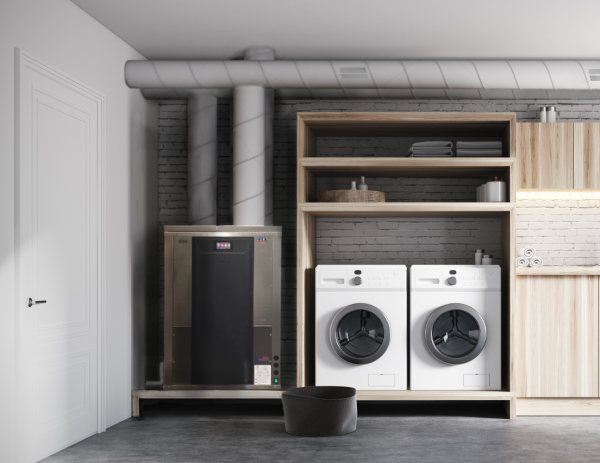We’ve progressed a bit more on the kitchen. The double oven and vent hood have been installed. This Friday or next Monday the granite counter and sink will be installed.
I’ll leave the rendering up to show the progress versus the final concept.
[nggallery id=158 template=caption]
The pantry is also nearing completion. This is the main storage room for the house and has plenty of room for seasonal decorations and other things in addition to food storage.
[nggallery id=159]
In the first guest bedroom a linseed oil sealer has been applied to the floor. Two coats have been applied so far. This should give the concrete a darker more finished look. Below is a picture of the floor after the second coat as it is still drying.
The moisture interaction with the concrete floor can have a major impact on the house conditioning because the concrete is able to absorb a substantial amount of moisture. We have looked into this with our house moisture simulation models and plan to run some tests in this bedroom and the other two guest bedrooms without the linseed sealer. This will allow us to assess the potential impact on the house comfort that will be seen should additional flooring area be sealed or covered.
[nggallery id=160]
The picture of the house on a sunny November day shows the passive solar entering the clerestory windows. In the interior picture you can see the sunlight is already at the top of the North wall windows. The light will move higher on the wall from here as the sun rises lower on the horizon throughout the winter. This keeps it from shining in the eyes of occupants in the rooms while providing light and heat.
[nggallery id=161]
Our house has only partially been taken over by the Army. These guys are actually from the US Army Corps of Engineers. They work for CERL (Construction Engineering Research Laboratory) based in Champaign and are helping us to study the air infiltration and ventilation of the house using a tracer gas method. From left to right they are Ben, Jim, Dino, and Tapan. Ben and Jim are good friends of ours, so it is fun to collaborate with them on this study.
In these tests we release CO2 into the house and measure the concentration decay over time. This is an alternate method to the blower door tests we ran many times over the past few months. So far we’ve found an unvented infiltration rate of 15 cfm, which is very good and supports the data from the blower door tests. We will also run these tests to determine the effectiveness of our ventilation strategy.
[singlepic id=754 w=200 h=150 float=]
It’s about time for another solar update and we’ve reached a milestone.
10,000 kW-hr!!!
Since the end of February when we activated the system we have produced 10,000 kW-hr. The figure below shows what we have produced in red and the blue shows what we have sent to the utility. The gap between the two is the amount of solar power that the house has used itself and not sent to the utility.
[singlepic id=755 w=200 h=150 float=]
The next figure again shows the total solar produced, but this time compared with the total electric used by the house. You can see that the amount used is much less than what has been produced. The electricity used has been divided into the energy used to construct the home and the energy we are using now to comfort condition and basically live in the home. This shows that the on site generation is without question more than enough to build a house using solar energy. We constantly reminded the construction crews that their air compressors, power tools, radios, and any other electric tools were completely powered by the sun.
[singlepic id=756 w=200 h=150 float=]
This final figure displays the total energy usage in green with the blue and red showing the portion supplied by direct solar and the utility respectively. About half of the energy used came directly from the solar. This represents energy consumed at the same time the sun is shining and we are producing power. The other half came from the energy credits we have built up at the utility because much more has been produced than used.
[singlepic id=757 w=200 h=150 float=]













